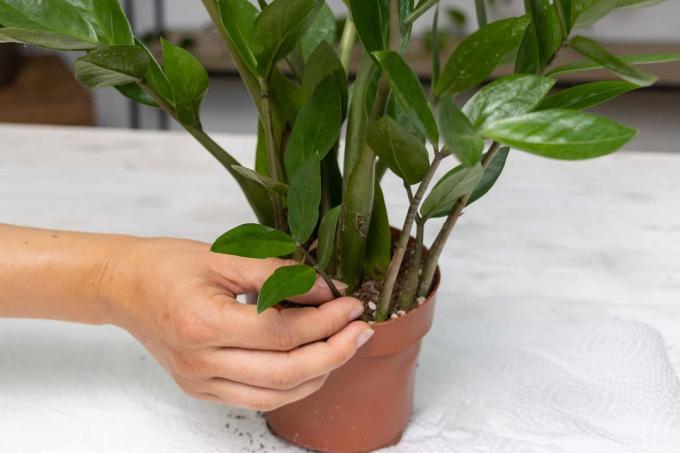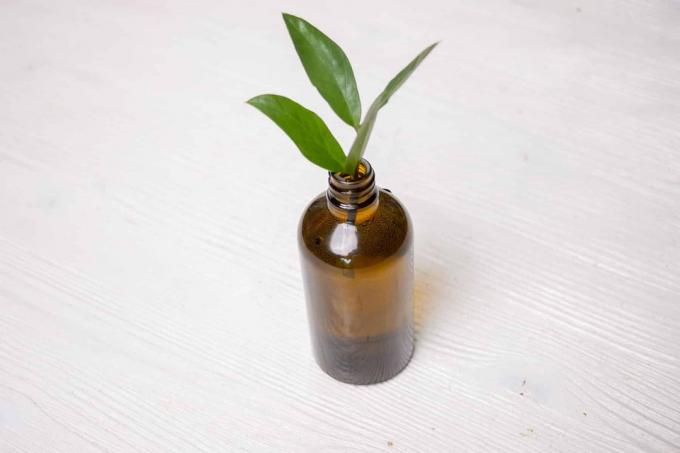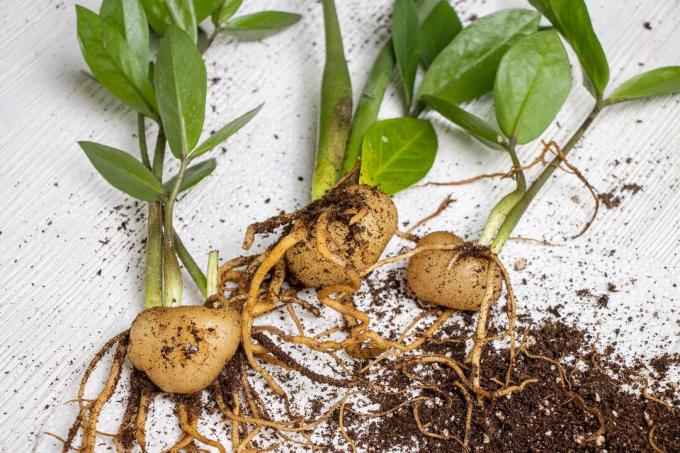
the lucky feather (Zamioculcas) are easy to propagate. So no one has to buy new specimens as long as they can cut shoots from a "mother plant". However, patience is required until roots appear in the glass of water.
In a nutshell
- root only shoots with 4-5 leaves in spring in water
- Cut cuttings with a sharp, disinfected knife
- Place in a dark glass container and fill with lukewarm, fresh water
- Choose a warm and bright location, avoid direct sun
- change water daily, plant in normal soil after rooting (after months).
Table of Contents
- Spring is the best time
- Rooting in water: instructions
- Other propagation methods
- frequently asked Questions
Spring is the best time
In the case of the lucky feather, rooting in a glass of water is only the recommended propagation method if you have cuttings with several leaves available.
Wait until spring to multiply, when the lucky feather awakens to new growth after the winter rest period. Also the better ones lighting conditions contribute to the fact that the propagation succeeds better and faster. If the cutting is in the water for a long time without ideal conditions, there is a risk that it will rot instead of forming roots.

Rooting in water: instructions
- Choose a sharp knife to get smooth cut surfaces.
- Disinfect the knife blade thoroughly, for example with alcohol. This minimizes the risk of harmful germs entering the mother plant or the cutting itself rotting.
- Select a petiole that has about four or five leaves and cut it off.
- Find a glass jar of the right size, if possible with a dark colour. The cutting must be able to find a good hold in it so that it does not lean to the side due to the weight of the leaves and eventually fall out.
- Fill the glass jar with fresh, lukewarm water.
- Put the shoot cuttings in the glass. The bottom end should be several inches in the water, but not a single leaf. Possibly. remove the lower leaves.
- Choose a suitable location where you will place the container with the cuttings for the duration of the rooting. It should offer plenty of light, no direct midday sun and constant warmth.
- Replace the old water with fresh water every day so that no harmful germs can settle and multiply. Make sure that the lower end of the cuttings is always in the water, especially on warm days.
- Don't lose patience in between. Hoping for successful propagation, do not dispose of the cuttings at all! In the case of the lucky feather, it is perfectly normal for the visible formation of roots to take place after several months.
- Check regularly to see if there are any changes. If small tubers form at the lower end of the shoot, propagation is on the right track. Continue to change the water daily.
- Remove the cutting from the water as soon as the small tubers have formed enough roots.
- Plant the rooted shoot in a small pot of normal potting soilwhere he can then develop further. But since the root formation is promoted first, the first new shoot will be a few weeks away.

Tip: Zamioculcas is light poisonous. Wear gloves when cutting the cuttings and any other steps that involve contact with the cuttings.
Other propagation methods
When you can't take a large cutting from your lucky feather, or any other If you don't want to propagate in water, you can use this houseplant in other ways increase:
- division of a larger plant
- Cut off young offshoots and plant
- Cut leaf cuttings and stick them into the substrate for rooting

Tip: For all of these methods, spring is the best time to trade, or early summer at the latest.
frequently asked Questions
Individual leaves are not suitable for rooting in water. They don't have a long stalk with which to stand in it. If the leaf itself is constantly in the water, it would soon begin to rot. Here, immediate planting in soil is the only sensible promising course of action.
Yes. But note that it is either an east or west-facing window. South window is unsuitable because the sun shines too intensely there. The north window offers too little light.
In principle this is possible. However, make sure that the glass is sufficiently large or wide to accommodate all the cuttings. The water level needs to be more tightly controlled as more water evaporates. In the final stages of rooting, it makes sense to separate the shoots so that the roots don't intertwine and possibly get damaged during later separation.



